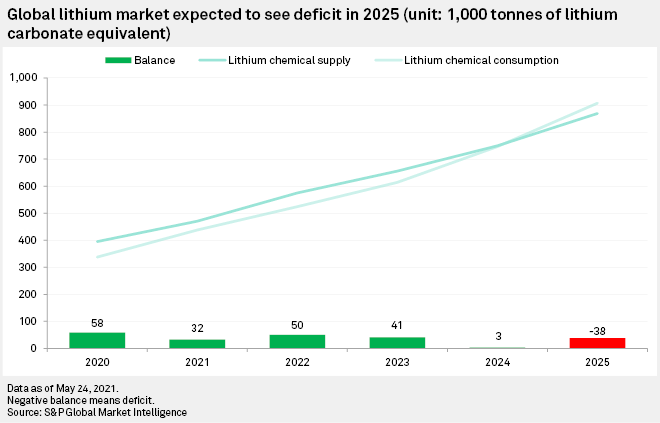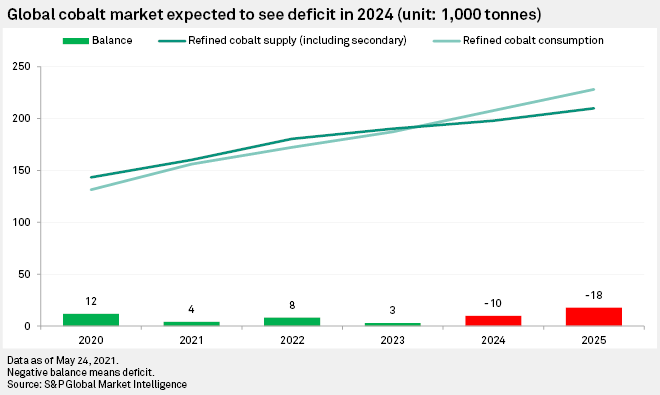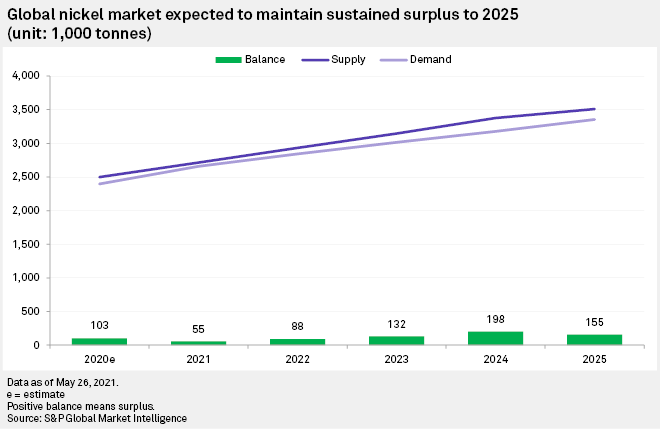S&P Global Offerings
Featured Topics
Featured Products
Events
S&P Global Offerings
Featured Topics
Featured Products
Events
S&P Global Offerings
Featured Topics
Featured Products
Events
Banking & Capital Markets
Economy & Finance
Energy Transition & Sustainability
Technology & Innovation
Podcasts & Newsletters
Banking & Capital Markets
Economy & Finance
Energy Transition & Sustainability
Technology & Innovation
Podcasts & Newsletters
S&P Global Offerings
Featured Topics
Featured Products
Events
9 Jun, 2021
By Tracy Hu, Anthony Barich, and Camille Erickson
Battery recycling efforts have picked up in major electric vehicle markets, but analysts said the industry still lacks well-established collecting systems and regulatory frameworks to provide sufficient secondary supply for manufacturers as potential shortages in key metals loom.
Some key components of EV batteries, such as lithium and cobalt, are expected to be in short supply after 2024, while nickel, another major EV battery component, will remain in a sustained market surplus to 2025, according to S&P Global Market Intelligence data.
As EV penetration rates increase through 2040 amid global efforts to transition to a low-carbon future, demand for battery materials is expected to soar. Demand for the critical minerals used in batteries for EVs and grid storage will grow by at least 30 times by 2040, the International Energy Agency estimated in a May report. The projected surge in used battery volumes presents an opportunity for the recycling industry to integrate into the battery supply chain, experts said.

The world's largest EV consumers, including Europe, the U.S. and China, are not major producers of mined nickel, lithium and cobalt, so an established recycling system could lower the dependence on imports with the production of domestic secondary supply, according to Alice Yu, a senior metals analyst at Market Intelligence.
However, the regulatory framework is not well-established. "In these major EV markets, the regulatory framework and national standards in terms of secondary use and recycling are still being drawn up," Yu said.
EV batteries manufactured over the next decade will likely have a minimal amount of recycled battery content, but that could change by the end of 2030, with recycled cobalt, nickel and lithium making up 10% to 20% of global demand, according to Ajay Kochhar, CEO and co-founder of the five-year-old Canadian battery recycling company Li-Cycle Corp.
Shift to recycled content
In response to supply pressure, there is expected to be a considerable increase in the amount of recycled cobalt sourced for batteries in the foreseeable future, according to a June outlook from Australia's Department of Industry, Science, Energy and Resources.
Growth in cobalt recycling is being driven by a steady increase in commercial-scale recycling as more batteries reach the end of their lives. Annual cobalt supply from recycling could reach 34,000 tonnes by 2030, with more than 80% sourced from batteries, according to the outlook. However, that may not be nearly enough.
The worsening supply shortfall forecast to 2030 for lithium and cobalt is a major challenge for EV makers in the EU and the U.S., Lithium Australia NL Managing Director Adrian Griffin said in an email interview.
"We can't keep heading in this direction and expect the supply of raw materials to hold up," Griffin said, referring to the rising use of lithium-nickel-cobalt-manganese batteries and lithium-nickel-cobalt-aluminum oxide batteries.
Amid high prices and supply issues in the cobalt market, some carmakers and battery makers have spent years exploring technology to reduce cobalt content.

Griffin noted that Tesla Inc. will use cobalt-free lithium-ion phosphate, or LFP, batteries for its energy storage needs, CEO Elon Musk confirmed on a first-quarter earnings call. Volkswagen AG said it will use LFP batteries in its "entry-level" EVs to halve costs, Reuters reported in March.
There has already been a shift in Chinese manufacturing to LFP batteries, Griffin noted. Major Chinese EV producer BYD Co. Ltd., which is competing with Tesla in Europe and China, is also expected to not produce any nickel- and cobalt-bearing batteries for its EVs in the future, Griffin added.
Griffin believes that up to 70% of the EV market will be using LFP batteries within five years and said this shift "remains a problem to all recyclers," as the value of the components is low.
In March, Lithium Australia had a patent application accepted for technology to make LFP cathode powder from recycled batteries, providing one solution for EV makers seeking cobalt-free batteries.

Building policy
In China, less than 10% of end-of-life or spent lithium-ion batteries are recycled or reused. Some analysts said the lack of dominant recycling players in major EV markets, such as China, can be traced to the limited profitability of the industry. Without dominant players, battery recycling is still a nascent industry without an established model that others could learn from, Yu said.
But battery recycling is gaining momentum amid a push from the government, according to analysts. In March, Chinese Premier Li Keqiang said the country would accelerate the development of power battery recycling systems while delivering the 2021 Government Work Report.
One factor in the push is that the government made original equipment manufacturers, or OEMs, responsible for collecting the spent batteries, Tu Le, an analyst at Beijing-based research firm Sino Auto Insights, said in an interview. The process resulted in a large number of companies entering the market in recent years to take on recycling.
Tu said the collection system in China is driven by automakers. OEMs partnered with battery manufacturers and other recycling partners to collect and dispose of retired batteries. Companies such as Tesla, BYD and NIO Inc. have their own systems of recycling and repurposing in partnership with their dealer network, Tu added.
Carmakers and battery manufacturers in China have been increasingly interested in battery recycling over the past few years as a way to maintain long-term supply, said Qin Jingjing, a nonferrous metals analyst at China Industrial Securities Co. Ltd. However, these companies faced challenges in securing effective recycling channels and adopting proper technology in the recycling process to avoid a negative environmental impact.
Harmonizing regulations
"The U.S. is probably a little bit behind from a recycling perspective," Rebecca Ciez said of lithium-ion batteries. Ciez is an assistant professor of mechanical and environmental engineering at Purdue University.
Lithium-ion batteries do not have the same recycling mandates as lead-acid batteries, according to Ciez. About 99% of lead-acid batteries in the U.S. are recycled, due to widely adopted recycling requirements, but the same regulations do not exist for lithium-ion batteries.
"It's also just a looming problem that we see coming, but it is not here yet, so it's hard to get a lot of infrastructure built for that," Ciez noted.
Eight U.S. states enacted waste management regulations for rechargeable batteries, but only three explicitly prohibit lithium-ion battery disposal in landfills, according to an April report published by environmental organization Earthworks.
The European Commission's battery recycling proposals include imposing standard recovery rates for certain battery materials and requiring new batteries to have a minimum amount of recycled content. Kochhar said the EU's planned regulatory framework on battery recycling is "probably the most forward-looking" possibility seen so far.
Looking beyond 2030, the lithium-ion battery recycling industry has the potential to become a closed-loop system, similar to what exists for lead-acid batteries, Kochhar said. In the meantime, Li-Cycle is bolstering profits by selling the battery materials it recovers — primarily lithium and cobalt, as well as graphite, copper and aluminum.
"The first phase is really driven [by] manufacturing battery scrap," Kochhar said. "That is important because it gives us a baseload for our business."
"We need to be unit-economic and profitable, meaning that this is not an activity that needs subsidies," Kochhar added. "This just works commercially."
